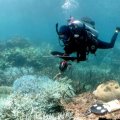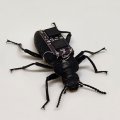The world’s first mammalian births in space are expected to occur during a $US15 million project to blast-off in 2005 and involving Australian and US universities.
Four of the crew members on the Mars Gravity Biosatellite Project are expected to give birth on Day 10 of the 49-day mission, which is expected to yield valuable data for human exploration of Mars.
The project is expected to be the longest unmanned orbital free flight biological experiment ever attempted.
After The Mars Society put forward the concept in 2001, students from The University of Queensland’s Centre for Hypersonics engaged with groups at the Massachusetts Institute of Technology (MIT) and the University of Washington (Seattle). They are designing, building and operating a low-earth orbiting spacecraft supporting the world-first experiment.
The UQ student group plans to have a complete, fully tested re-entry capsule or “Entry, Descent and Landing (EDL) System” in only two years time, by around August, 2004. It will be the first time Australians have developed such a system.
The Australian group is also planning the spacecraft recovery, with the Woomera Prohibited Area in the South Australian desert a candidate site. The UQ group needs to raise $AU 1 million to undertake this project.
Australian project manager and PhD student in the Centre for Hypersonics Jason Hoogland said the Mars Gravity Biosatellite would carry a group of mice and observe them as they lived freely in a simulated gravity environment for seven weeks.
“It will be very similar to the gravity found on the surface of the planet Mars, which is about one-third of that on Earth,” said Mr Hoogland, who is 2002 Young Queensland Engineer of the Year.
“The health and safety of the crew will be paramount to the success of the mission. Lights inside Biosatellite will switch on-and-off in 12-hour cycles. The crew’s air supply will be recirculated to remove odours and contaminants from their waste. We intend to return them safely to Earth.”
Mr Hoogland said there would be computerised and video-monitoring and the mice would be returned early if their life support systems began to malfunction as it was easier to study any physiological changes in a living animal.
However, some of the Biosatellite crew would meet their end on the dissection table, in the cause of science.
“The changes observed in their bones and muscles will provide information vital to the planning of future human Mars missions. Such missions are expected to be undertaken within the next few decades and will at first require astronauts to spend around 18 months on the Martian surface. But we know little about how our bodies will respond in this situation of 3/8th gravity,” he said.
“Plans for human missions to Mars have evolved significantly and dropped in cost in the past 10 years so capturing this data is becoming increasingly important.
“The information gained also could be useful in understanding the progress of such human diseases as osteoporosis and cellular biochemical processes, which are very dependent on gravity.
“The program therefore has the potential for fundamental breakthroughs with biotechnology spin-off potential.”
Mr Hoogland said while this project was first and foremost a cutting-edge scientific endeavour, it also was a unique, project-oriented learning experience.
“We have 22 students, ranging from PhD level to fourth and third year students at UQ all interacting and supporting each other as a team. We have very high motivation levels and students volunteer much of their personal time. There is also international teamwork and we rely heavily on email, ftp and teleconferencing between the three schools’ research teams,” he said.
Mr Hoogland said students at the three universities had received much encouragement from people within NASA who would have loved to have conducted these experiments 30 years ago.
The Australian group is in a fortunate position because UQ’s Centre for Hypersonics has more than 40 years experience in hypersonic ground-testing of Earth and interplanetary orbital conditions, and more recently, sub-orbital conditions with the successful HyShot scramjet project.
The project has now entered the preliminary design phase, and has raised around US$120,000. Researchers are seeking additional funding from a variety of sources.
It is being sponsored by the Director of the Centre for Hypersonics, Professor Richard Morgan, who is pursuing a student exchange scheme between the schools. The project has received $25,000 support from the University’s Engineering, Physical Sciences and Architecture Faculty.
Media contact: Jason Hoogland telephone 07 3365 4067, or email hoogland@mech.uq.edu.au.
.jpg)


